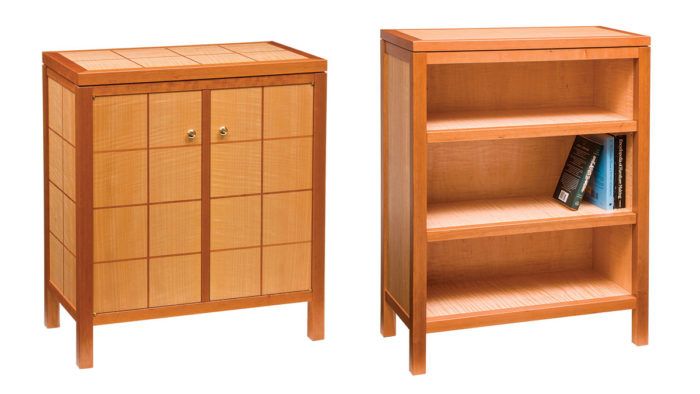How to Build Beautiful Cases from Plywood
Smart joinery turns eye-catching panels into sturdy furniture
Synopsis: There’s a lot of creative freedom in building cases with veneered panels. Veneer makes it possible to use a variety of exotic woods and dramatic figure, and wrapping those patterns around the entire case piece. Veneered panels also make it possible to use an entirely different look for the inside of the case. Craig Thibodeau has been building furniture this way for years, and shares his methods so the experience will be easier for you. It starts with the substrate, then moves on to design and joinery, whether you choose a frame-and-panel case or the smooth look of a mitered case piece.
A lot of articles have been written about making veneered panels with a vacuum bag. Most of these take you as far as trimming the panel and popping it into a door frame, or maybe applying edging and turning that panel into a tabletop. Those techniques are important, but there’s much more you can do.
I’ve been building entire case pieces with veneered panels for years. With them, I can make pieces that are simply not possible with traditional methods. I love the creative freedom: the variety of exotic woods and dramatic figure available, the ability to make patterns with these veneers (see Master Class, FWW #240), and then being able to wrap these woods and patterns around an entire piece. Another great benefit of veneered panels is that I can give the interior of a case a completely different look.
Although there is not a lot of information available on building furniture this way, I’ve learned how to make the process easy and the results flawless. The first secret lies inside the panel itself.

The core is the heart of the method
How you build with veneered panels depends a lot on what they’re made of. The usual candidates for core materials involve a trade-off. Baltic-birch plywood, for instance, is very strong and stable, and holds fasteners well, but it’s expensive and heavy. MDF, which I used for years, is cheap and glue joints, and the whole panel takes fasteners well, such as splines, screws, biscuits, and more.
To this core I typically add a skin of 1⁄8-in.-thick MDF on each side. This gives me the perfect surfaces I need for veneering. If I want thicker panels I use 1⁄4-in. MDF for the skins or add a second layer of lumber core in the center.
Making custom cores doesn’t take much extra effort: it’s just one more glue-up before the veneering stage. I cut the parts 1 in. oversize in each direction, so alignment isn’t critical. I apply yellow glue to one face of each layer, and then put the sandwich in the vacuum bag for an hour or two. Then I apply the veneer in a separate step. one helpful tip is to leave one edge of the lumber-core plywood slightly proud so it can be used as a reference edge when trimming the panel to final size later.
For thinner case components like doors and drawer dividers, I go back to simple Baltic-birch plywood as the substrate. It’s available in a variety of thicknesses. For a stable panel, be sure to run the veneer grain at right angles to the grain on the face of the plywood. These thin components tend to have exposed edges, which I veneer first before veneering the faces. To see how I do that, go to FineWoodworking.com/extras.
Video: Domino System Makes Joinery Fast and Easy
Article: How to Edge Veneered Parts for a Clean Look
Photo: Asa Christiana
For the full article, download the PDF below:
Fine Woodworking Recommended Products

Estwing Dead-Blow Mallet

Festool DF 500 Q-Set Domino Joiner























Comments
Craig, after listening to your @makercast interview where you reference FW mag, I went back and reread all of your FW articles. Each of your articles contains many good ideas and are informative. I love your marquetry work as well. This article has some great techniques, and as you mentioned, what you cover is not usually included in a veneering article.
Beautiful cases out of lowly plywood. I love the simple construction and the imaginative designs. And the construction and joints look pretty bomb proof
Log in or create an account to post a comment.
Sign up Log in